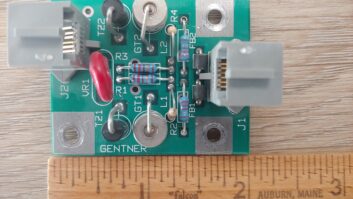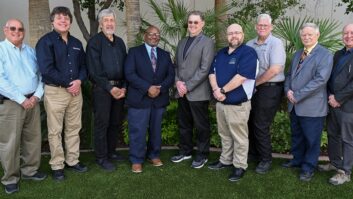
Frank Hertel’s “Repair and Protect Type ‘N’ Connectors” tip got a lot of attention. Frank is not the only engineer who has “been there, done that.”
San Francisco contract and projects engineer Bill Ruck was the first to offer further thoughts on the subject.
Bill is not sure if the silicone fuel line is completely benign. While silicone has a reasonable dielectric constant, it is not 1.000. Remember that a “compatible 75-ohm BNC” has the same pin diameter and the same shield diameter as a 50-ohm BNC but is only lacking the plastic around the female socket.
That is just enough difference to make it near 75 ohms. Adding the piece of silicone tubing may not make a major difference at 950 MHz, but at higher frequencies, the addition could be an issue by lowering the impedance of the junction. In other words, it might not be a great idea if the feed is for a C-band antenna.
Bill also cautions that true 75-ohm Type N connectors that can be found on translators. The pin and socket diameters are smaller than the common 50-ohm Type N connectors.
If you put a male 75-ohm plug into a female 50-ohm socket, it likely will not make good contact. And the opposite is worse — if you put a 50-ohm male pin into a female 75-ohm socket, you will likely destroy the socket by breaking off the fingers. Bill says he learned both lessons the hard way!
Bill also learned a long time ago, from Norm Philips at Susquehanna Radio, to use 7/8-inch EIA connectors on 950 MHz antennas instead of Type N connectors. These are much stronger, much more waterproof, and it has been Bill’s experience that once installed, he never had to do anything with them — they just worked.
Bill discovered the hard way to avoid flexible jumpers on all antennas, but instead made a full loop at about 1 1/2 times the minimum bending radius at the connector. This gives just enough flexibility to make the connection, and at the same time avoids another connector junction. This technique works great with 1/2-inch coax and even with 7/8-inch coax.
A U.S. Navy veteran, Bill learned in the service to put protective caps on all connectors when not in use. Since he has written the checks for his personal test equipment, Bill is careful to keep the connectors in good shape. The plastic caps keep out dust and dirt as well as protect the connectors. Bill would collect those caps but started to run out of the Type N size.
It turns out that they are relatively inexpensive and readily available, but you have to purchase 100 of them, a lifetime supply — if you live long enough. (At www.mscdirect.com, search for part number 31992233, seen in Fig. 1).
***
WA4MZZ, Sheldon Daitch, found the repair of splayed Type N center pins interesting. Sheldon also pointed out that the center pin diameter changes between 50-ohm and 75-ohm connectors. In the example shown by Frank and Dave Hertel, it would appear the center female connector damage shown could be the result of the use of the wrong impedance male connector.
***
Tony Dinkel is with Entercom Las Vegas and also offered a comment about Type N female connector repair. Tony says the cause of damaged female Type N connectors is usually improperly assembled Type N male connectors. If proper attention to detail is paid to the alignment and protrusion of the center pin of the Type N male connector, repairs should not be needed.
Over the years, Tony has found and repaired some botched-up connector assemblies, including replacing chassis-mounted female Type N connectors on very expensive equipment. All it takes is a quick look at the center pin of the male Type N connector to see if it is centered and not protruding out too far.
So Tony’s recommendation is to take a moment and check the male connector before inserting, to prevent the splayed center conductor in the first place.
***

Site security is always on an engineer’s mind. Here’s a simple tip that can keep your site safer.
On combination locks, when arriving or leaving the site, always return the combination lock dials to 0-0-0-0 (Fig. 2).
This does two things. First, if you arrive at the site and the combination is set to something else, you know vandals may have visited your site. Also, leaving the combination exposed (by not returning the dials to 0-0-0-0) could allow a passerby to copy the combination and enter later.
Simple, yet secure.
***
K.M. Richards is a unique programming consultant who, in addition to providing programming consulting, has a background in keeping several low-power FMs on the air and spent a lot of time in the studio in the ’80s. Although he doesn’t consider himself an engineer, he reads Radio World cover to cover to stay abreast of topics that can help his clients.
This also lets K.M. have intelligent conversations with the station engineers. K M. writes that one of his personality traits, which endears him to most engineers, is that he’s good at organizing and planning.
In the May 23, 2017, Workbench column, K.M. wrote that when taking a set of “normal” readings of equipment, he brought along his battery-powered label maker. Those “normal” readings were then placed on or near the equipment. In an emergency, this gives you virtually instant access to “normal” readings, eliminating searching through a notebook or smartphone. If that’s not practical for some reason, add a page to that binder showing the signal paths listing every piece of equipment with its normal readings, perhaps on the page opposite your rack path diagram.
Being prepared is good advice. Making sure the preparations are somewhere that you don’t have to panic to find and use them is even better.
Contribute to Workbench. You’ll help fellow engineers and qualify for SBE recertification credit. Send Workbench tips and high-resolution photos to [email protected]. Fax to (603) 472-4944.
Author John Bisset has spent 49 years in the broadcasting industry and is still learning. He handles Western U.S. Radio Sales for the Telos Alliance. He is SBE certified and is a past recipient of the SBE’s Educator of the Year Award.












